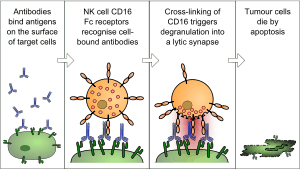Antibody-dependent cell-mediated cytotoxicity

The antibody-dependent cell-mediated cytotoxicity (ADCC) is a mechanism of cell-mediated immune defense whereby an effector cell of the immune system actively lyses a target cell, whose membrane-surface antigens have been bound by specific antibodies.[1] In humans, ADCC is usually mediated by IgG. It is one of the mechanisms through which antibodies, as part of the humoral immune response, can act to limit and contain infection.[2]
Classical antibody-dependent cell-mediated cytotoxicity is mediated by natural killer (NK) cells; but macrophages, neutrophils and eosinophils can also mediate it.[1] For example, eosinophils can kill certain parasitic worms known as helminths through ADCC mediated by IgE.
ADCC is part of the adaptive immune response due to its dependence on a prior antibody response.
By NK cells
The typical ADCC involves activation of NK cells by antibodies. A NK cell expresses Fc receptors, mostly CD16. These receptors recognize, and bind to, the Fc portion of an antibody, such as IgG, which has bound to the surface of a pathogen-infected target cell. The most common Fc receptor on the surface of an NK cell is called CD16 or FcγRIII. Once the Fc receptor binds to the Fc region of IgG, the Natural Killer cell releases cytokines such as IFN-γ
During replication of a virus some of the viral proteins are expressed on the cell surface membrane of the infected cell. Antibodies can then bind to these viral proteins. Next, the NK cells which have Fc Receptors will bind to that antibody, inducing the NK cell to release proteins such as perforin and proteases known as granzymes, which causes the lysis of the infected cell to hinder the spread of the virus.
Furthermore, NK cells are involved in killing tumor cells and other cells that may lack MHC I on their surface, indicating a non-self cell. This is because, generally, all nucleated cells (which excludes RBCs) of the body contain MHC I.
By eosinophils
Large parasites like helminths are too big to be engulfed and killed by phagocytosis. They also have an external structure or integument that is resistant to attack by substances released by neutrophils and macrophages. After IgE coat these parasites, the Fc receptor (FceRI) of an eosinophil will then recognize IgE. Subsequently, interaction between FceRI and the Fc portion of helminth-bound IgE signals the eosinophil to degranulate.
In vitro
Several laboratory methods exist for determining the efficacy of antibodies or effector cells in eliciting ADCC. Among these methods include chromium-51 [Cr51] release assay, europium [Eu] release assay, and sulfur-35 [S35] release assay. Usually, a labelled target cell line expressing a certain surface-exposed antigen is incubated with antibody specific for that antigen. After washing, effector cells expressing Fc receptor CD16 are co-incubated with the antibody-labelled target cells. Target cell lysis is subsequently measured by release of intracellular label by a scintillation counter or spectrophotometry.
A common challenge faced by ADCC assays is high background signaling due to cellular "leakiness". While both Cr51 and Eu-based assays face this challenge, S35-containing methionine and cysteine pre-incubated with target cells leads to incorporation of radio-labelled molecules into newly translated peptides.
The coupled bioluminescent method aCella TOX is now in widespread use for ADCC and other cytotoxicity assessments. Since this technique measures the release of enzymes naturally present in the target cells, no labeling step is required and no radioactive agents are used.
Monoclonal antibody action against tumors
Experiments in mice indicate that ADCC is an important mechanism of action of therapeutic monoclonal antibodies, including trastuzumab and rituximab, against tumors.[3] In the clinic the FcgRIII 158V/F polymorphism interfere with the ability to generate ADCC responses in vitro during trastuzumab treatment.
See also Afucosylated monoclonal antibodies.
References
- 1 2 Hashimoto, G.; Wright, P. F.; Karzon, D. T. (1983-11-01). "Antibody-dependent cell-mediated cytotoxicity against influenza virus-infected cells". The Journal of Infectious Diseases. 148 (5): 785–794. doi:10.1093/infdis/148.5.785. ISSN 0022-1899. PMID 6605395.
- ↑ Pollara, Justin; Hart, Lydia; Brewer, Faraha; Pickeral, Joy; Packard, Beverly Z.; Hoxie, James A.; Komoriya, Akira; Ochsenbauer, Christina; Kappes, John C. (2011-08-01). "High-throughput quantitative analysis of HIV-1 and SIV-specific ADCC-mediating antibody responses". Cytometry Part A. 79 (8): 603–612. doi:10.1002/cyto.a.21084. ISSN 1552-4930. PMC 3692008
 . PMID 21735545.
. PMID 21735545. - ↑ Clynes, RA; Towers, TL; Presta, LG; Ravetch, JV (2000). "Inhibitory Fc receptors modulate in vivo cytoxicity against tumor targets". Nat Med. 6 (4): 443–6. doi:10.1038/74704. PMID 10742152.
Further reading
- Janeway CA, Jr.; et al. (2001). Immunobiology. (5th ed.). Garland Publishing. ISBN 0-8153-3642-X. (electronic full text via NCBI Bookshelf).
- Pier GB, Lyczak JB, Wetzler LM (2004). Immunology, Infection, and Immunity. ASM Press. ISBN 1-55581-246-5.
External links
- University of Leicester, Virus Immunopathology Notes
- Antibody-Dependent Cell Cytotoxicity at the US National Library of Medicine Medical Subject Headings (MeSH)